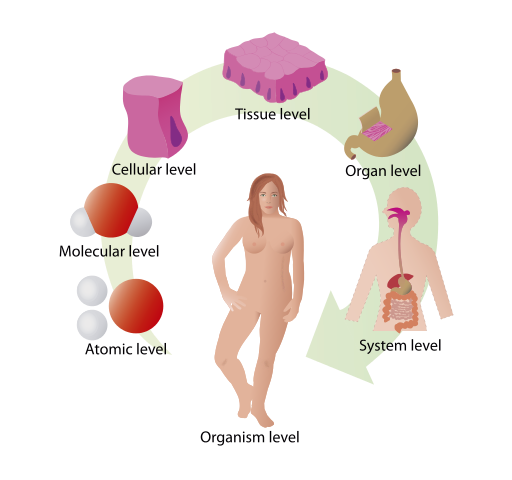2.1.1. Basics of Biology, Anatomy, and Physiology
The Basic Structural and Functional Unit of Life: The Cell
Figure 2.1.1.1 Components of Organ Systems in the Human Body

Source: Basics of Biology anatomy and human physiology.
What distinguishes a living organism from an inanimate object? A living organism conducts self-sustaining biological processes. A cell is the smallest and most basic form of life.
The cell theory incorporates three principles.
Cells are the most basic building units of life. All living things are composed of cells. New cells are made from preexisting cells, which divide in two. Who you are has been determined because of two cells that came together inside your mother’s womb. The two cells containing all of your genetic information (DNA) united to begin making new life. Cells divided and differentiated into other cells with specific roles that led to the formation of the body’s numerous body organs, systems, blood, blood vessels, bone, tissue, and skin. As an adult, you are made up of trillions of cells. Each of your individual cells is a compact and efficient form of life—self-sufficient, yet interdependent upon the other cells within your body to supply its needs.
Independent single-celled organisms must conduct all the basic processes of life. The single-celled organism must take in nutrients (energy capture), excrete wastes, detect and respond to its environment, move, breathe, grow, and reproduce. Even a one-celled organism must be organized to perform these essential processes. All cells are organized from the atomic level to all its larger forms. Oxygen and hydrogen atoms combine to make the molecule (H2O). Molecules bond together to make bigger macromolecules. The carbon atom is often referred to as the backbone of life because it can readily bond with four other elements to form long chains and more complex macromolecules. Four macromolecules—carbohydrates, proteins, and nucleic acids—make up all of the structural and functional units of cells.
Although we defined the cell as the “most basic” unit of life, it is structurally and functionally complex (Figure 2.1.1.2. “The Cell Structure”). A cell can be thought of as a mini-organism consisting of tiny organs called organelles. The organelles are structural and functional units constructed from several macromolecules bonded together. A typical animal cell contains the following organelles: the nucleus (which houses the genetic material DNA), mitochondria (which generate energy), ribosomes (which produce protein), the endoplasmic reticulum (which is a packaging and transport facility), and the golgi apparatus (which distributes macromolecules). In addition, animal cells contain little digestive pouches, called lysosomes and peroxisomes, which break down macromolecules and destroy foreign invaders. All of the organelles are anchored in the cell’s cytoplasm via a cytoskeleton. The cell’s organelles are isolated from the surrounding environment by a plasma membrane.
Figure 2.1.1.2 The Cell Structure

Source: Basics of Biology anatomy and human physiology.
The cell is structurally and functionally complex.
Tissues, Organs, Organ Systems, and Organisms
Unicellular (single-celled) organisms can function independently, but the cells of multicellular organisms are dependent upon each other and are organized into five different levels in order to coordinate their specific functions and carry out all of life’s biological processes (see Figure 2.1.1.3 “Organization of Life”).
- Cells are the basic structural and functional unit of all life. Examples include red blood cells and nerve cells. There are hundreds of types of cells. All cells in a person contain the same genetic information in DNA. However, each cell only expresses the genetic codes that relate to the cell’s specific structure and function.
- Tissues are groups of cells that share a common structure and function and work together. There are four basic types of human tissues: connective, which connects tissues; epithelial, which lines and protects organs; muscle, which contracts for movement and support; and nerve, which responds and reacts to signals in the environment.
- Organs are a group of tissues arranged in a specific manner to support a common physiological function. Examples include the brain, liver, and heart.
- Organ systems are two or more organs that support a specific physiological function. Examples include the digestive system and central nervous system. There are eleven organ systems in the human body (see Table 2.1.1.1 “The Eleven Organ Systems in the Human Body and Their Major Functions”).
- An organism is the complete living system capable of conducting all of life’s biological processes.
Figure 2.1.1.3 Organization of Life

Table 2.1.1.1 The Eleven Organ Systems in the Human Body and Their Major Functions
| Organ system | Organ components | Major function |
| Cardiovascular | heart, blood/lymph vessels, blood, lymph | Transport nutrients and waste products |
| Digestive | mouth, esophagus, stomach, intestines | Digestion and absorption |
| Endocrine | all glands (thyroid, ovaries, pancreas) | Produce and release hormones |
| Immune | white blood cells, lymphatic tissue, marrow | Defend against foreign invaders |
| Integumentary | skin, nails, hair, sweat glands | Protective, body temperature regulation |
| Muscular | skeletal, smooth, and cardiac muscle | Body movement |
| Nervous | brain, spinal cord, nerves | Interprets and responds to stimuli |
| Reproductive | gonads, genitals | Reproduction and sexual characteristics |
| Respiratory | lungs, nose, mouth, throat, trachea | Gas exchange |
| Skeletal | bones, tendons, ligaments, joints | Structure and support |
| Urinary | kidneys, bladder, ureters | Waste excretion, water balance |
Note: There are 11 organ systems in the body which are all made up of specific components and all have different functions to sustain life. Source: Basics of Biology anatomy and human physiology.

